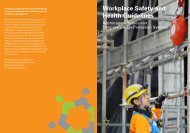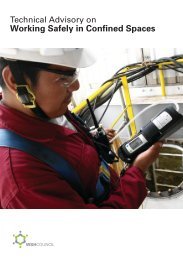Fatigue Management - Workplace Safety and Health Council
Fatigue Management - Workplace Safety and Health Council
Fatigue Management - Workplace Safety and Health Council
You also want an ePaper? Increase the reach of your titles
YUMPU automatically turns print PDFs into web optimized ePapers that Google loves.
Strategies on Coping with Dem<strong>and</strong>s of Work<br />
Include rest periods in the work schedule. When deciding on the length <strong>and</strong> frequency of breaks,<br />
consider:<br />
• The type of work being performed, for example, a task requiring greater physical <strong>and</strong>/or<br />
mental effort would need a longer total break time per shift;<br />
• The length of shifts worked; the longer the shift, the longer the total break time required per<br />
shift;<br />
• A facility for resting;<br />
- Provide <strong>and</strong> designate proper facility for employees to rest.<br />
-The facility should be conducive to rest/sleep (e.g. clean, dim lighting, quiet, <strong>and</strong> temperature<br />
of the room).<br />
• Include power nap2 of at least 20 minutes <strong>and</strong> at most 30 minutes to avoid falling into the<br />
deeper stages of sleep;<br />
• Avoid safety critical work immediately after a nap to avoid adverse sleep inertia effects.<br />
• Include activity breaks. For example, certain work activities can be monotonous <strong>and</strong> require<br />
a person to st<strong>and</strong> or sit in a fixed position for extended periods of time:<br />
- Include short period of exercise, for example, stretching of the limbs <strong>and</strong> body, to provide<br />
a short term boost to alertness, mainly due to the change in posture of the affected<br />
persons; <strong>and</strong><br />
- Encourage employees to take scheduled breaks to relieve fatigue due to monotony of<br />
task.<br />
Manual Tasks<br />
Manual tasks are workplace activities that require the use of force or exertion by a<br />
person such as to lift, push or pull an object/load. Examples include manual h<strong>and</strong>ling<br />
of heavy loads, retrieval of items from shelving, <strong>and</strong> stacking of items. The prolonged<br />
performance of repetitive tasks, without adequate chance of rest <strong>and</strong> recovery, may<br />
result in an occupational injury.<br />
The risk of a musculoskeletal injury occurring may also be increased with extended<br />
shifts due to the cumulative effects of muscle fatigue, strains <strong>and</strong> sprains. Twelve hours<br />
shifts increase the risk of injury occurring. In general, workers involved in repetitive<br />
manual tasks should have regular breaks.<br />
• Ensure adequate manpower to avoid excessive dem<strong>and</strong>s <strong>and</strong> overloading on employees;<br />
• Increase supervision during period of low level of alertness; <strong>and</strong><br />
• Encourage interaction among employees to maintain alertness.<br />
3.2 <strong>Fatigue</strong> <strong>Management</strong> Techniques<br />
3.2.1 Measurement of <strong>Fatigue</strong><br />
Both quantitative <strong>and</strong> qualitative measurements can assess whether fatigue is prevalent in the<br />
workplace.<br />
Quantitative measurement examples include:<br />
• Medical leave records;<br />
• Staff turnover records; <strong>and</strong><br />
• Incidents relating to effects of fatigue.<br />
Indicator Description<br />
Absentee rates <strong>Fatigue</strong>d employees tend to be absent from work more often.<br />
Staff turnover rates <strong>Fatigue</strong> can result in job dissatisfaction.<br />
Use/abuse of substances E.g. Alcohol, cigarettes, sleeping pills etc.<br />
Work-related strains<br />
Stimulant usage<br />
Lost productive time<br />
Table 1: Indicators for Determining Level of <strong>Fatigue</strong>.<br />
<strong>Fatigue</strong>d employees tend to get injured easily. A rise in injury<br />
claims is a factor that may be indicative of fatigue.<br />
<strong>Fatigue</strong>d employees are likely to smoke <strong>and</strong> take prescribed or<br />
non-prescribed stimulants, such as caffeine.<br />
<strong>Fatigue</strong>d employees will result in lower productivity due to<br />
poorer work performance <strong>and</strong> health-related issues.<br />
Qualitative measurement through management <strong>and</strong> employees consultation. Examples include:<br />
• Employee surveys;<br />
• Focus groups; <strong>and</strong><br />
• Exit interviews.<br />
Question Guidelines<br />
How long have you kept<br />
yourself awake?<br />
How long have you worked<br />
without taking a break?<br />
The longer a person stays awake, the deeper the extent<br />
of fatigue. Generally, performance begins to deteriorate<br />
greatly after 18-20 hrs of continuous wakefulness.<br />
Working shifts that are longer than eight or nine hours can<br />
result in an increased probability of having accidents or<br />
making errors.<br />
2Power nap is a short duration of sleep of about 20 minutes to 30 minutes.<br />
How much sleep have you Most people require about 8 hours of sleep every 24 hours<br />
18 taken the previous night? for optimum alertness <strong>and</strong> performance.<br />
Research has shown that just 2 hours of sleep loss produces<br />
19

















